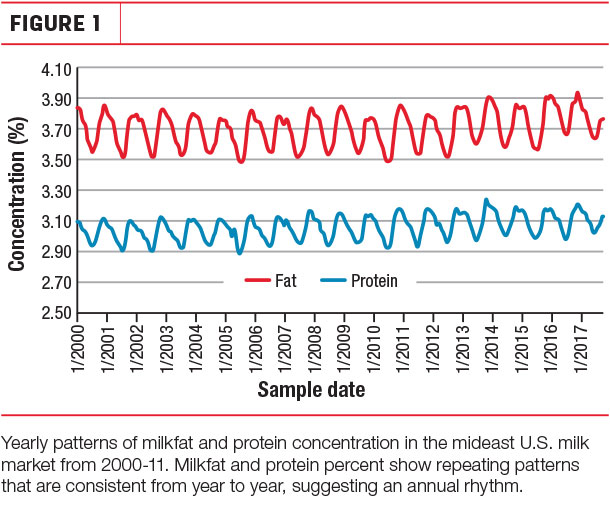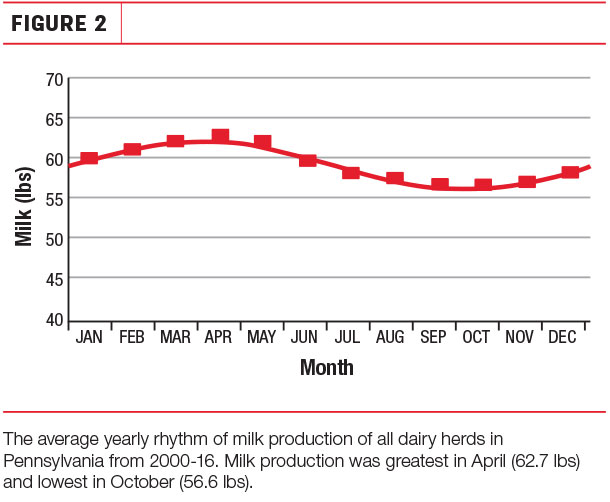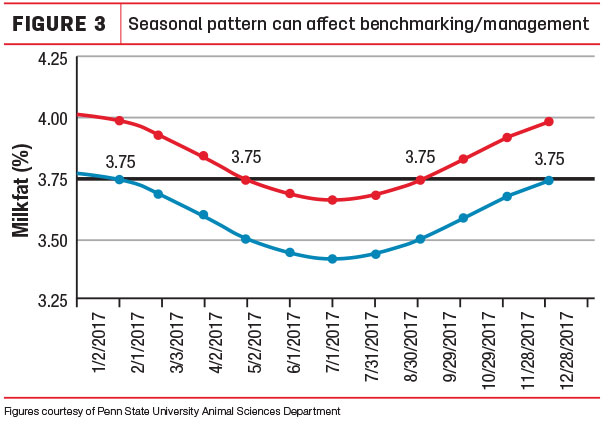Many factors can impact milk yield and milk composition. In today’s milk market, where income generated from units of milkfat and protein account for the bulk of your milk check, optimizing fat and protein yields and percentages is a goal for most dairy farmers.
Understanding what factors influence these changes in milk yield and composition, and determining the degree to which those factors can be managed or not, can be an important step in maximizing income.
Isaac Salfer and Kevin Harvatine of Penn State University Animal Sciences Department have been researching seasonal changes in milkfat and protein yields and percentages. Salfer presented this research at the 2017 Penn State Dairy Nutrition Workshop.
Influences on composition and yield
Many factors are already known to contribute to changes in milk and component yields and component percentages. Some of these, such as the stage of lactation, genetics and parity, are biological factors that can’t be altered through individual cow management. Others, such as cow nutrition or the impact of heat stress, can be controlled, and changes in herd management can help to optimize those milk variables.
But a seasonality to the rhythms of milk, fat and protein yields, as well as component percentages, seems to exist outside of the influence of these other factors. It’s this underlying seasonal rhythm the researchers are attempting to quantify and better understand.
Changes in the photoperiod, or the light-dark cycle, are known to impact milk production. Enhanced production of prolactin, triggered by lengthening days, causes increases in yields of milk, milkfat and milk protein. In dry cows, shorter days during the dry period are believed to cause proliferation of mammary cells, which then will increase milk production during the next lactation.
The photoperiod isn’t believed to play any major role in milk component percentages, however. Protein and fat percentages in milk are known to peak in January and dip to their lowest levels in July. This seasonality to component percentages has been shown to be consistent across all herds (Figure 1).

“The effect of the photoperiod is somewhat opposite of what we actually see, due to the cows’ seasonal rhythm,” Salfer said. “Milk yield is lowest in August and September, a time when photoperiod is expected to be relatively long compared to the winter. It’s also interesting that fat and protein concentrations are highest in winter,” as calves born in the winter require increased energy and nutritional density from the milk in order to survive.
Milk, fat and protein yields also show seasonal rhythms, but these are slightly askew from the rhythms of the fat and protein percent. Milk yields peak in early spring, while fat and protein yields peak in winter (Figure 2).

Data from individual herds in Pennsylvania further suggest that annual rhythms of milk, fat and protein yields are more variable between herds than are the fat and protein concentration rhythms.
This can be explained by genetics, as milkfat is the most heritable production trait, Salfer said. The presence of the causative gene – DGAT1 – explains a substantial amount of the differences between cows. Yet regardless of DGAT genotype, cows continue to display the same annual pattern of changes in milkfat percent.
Underlying rhythms
Salfer has analyzed herd- level data from multiple states – Texas, Florida, Minnesota and Pennsylvania – taken from DHIA records, spanning the 12-year period between 2004-16. Milk yield, as well as fat and protein yields, and component percentages were studied to help discern the reasons behind the seasonal patterns seen.
The analysis exposed regional differences. In Northern states, milk component percentages had a more pronounced seasonal pattern than was seen in the South. In Southern states, the milk component percentages did not vary as much throughout the year, but the yields did, showing more significant seasonal changes than herds in Northern regions.
Salfer and Harvatine tried to determine if the patterns seen were simply a function of temperature and related to the effect of heat stress. But their research showed that an underlying annual rhythm better explained the yearly changes in milk production than did environmental temperature patterns.
“This suggests that the effect is caused by factors outside of the temperature,” Salfer said.
Annual rhythms, similar to the circadian rhythm, are a natural part of the animal’s biology. Hibernation and migratory behaviors are examples of natural biological phenomena that display annual rhythms. These are caused by cells in the brain acting as a calendar, allowing the animal to recognize the time of the year.
While these rhythms are usually set by the photoperiod, they persist even when the animal’s exposure to the normal photoperiod is significantly altered.
What similar factors might be causing some of the seasonality patterns seen in milk and component yields, as well as component percentages? What impact does this underlying seasonality in milk composition and production patterns have on milk quality and herd management?
While Salfer and other researchers continue their quest for answers, their research has already led to some practical applications for dairy farmers.
“We want farmers to be aware of this rhythm,” Salfer said. “It is something that we don’t yet know how to manage around.”
Simply due to the seasonal rhythmical patterns, there will be an expected average 0.3 percent increase in milkfat percentage from July to January in the northern U.S. In the southern U.S, this change averages between 0.1 and 0.2 percent. Holding all other factors equal, dairy farmers will likely see this change, Salfer said.
“Keep in mind that annual rhythm,” Salfer said. “A 3.8 percent milkfat is better in July than the same 3.8 percent in January.”
While all of the mechanisms might not yet be fully understood, the bottom line is that milk yield, component yields and component percentages should increase at a known rate from July to January, based on an underlying natural pattern of seasonality. If this is not happening, then there are management changes that need to be made to capture lost production potential (Figure 3).

To help farmers account for the natural seasonal rhythm, Salfer is hoping to eventually be able to formulate “equations or adjustment factors” that would quantify these changes and allow farmers to see the effects of herd management changes more clearly.
Dairy farmers would then have a baseline of seasonal patterns “controlled by the animals’ internal biology,” Salfer said. “All variables are impacted by seasonal rhythms.” ![]()
Tamara Scully, a freelance writer based in northwestern New Jersey, specializes in agricultural and food system topics.





